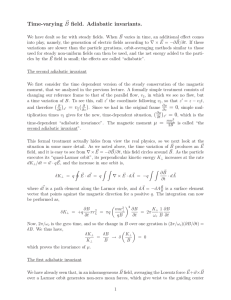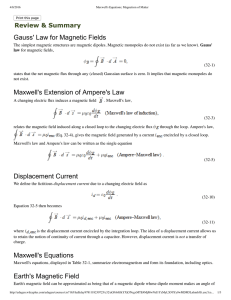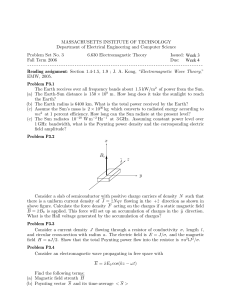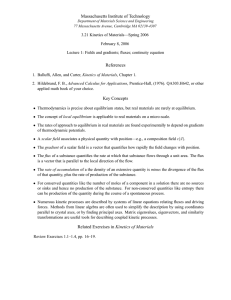Chapter 3 Dynamics of the Electromagnetic Fields
advertisement
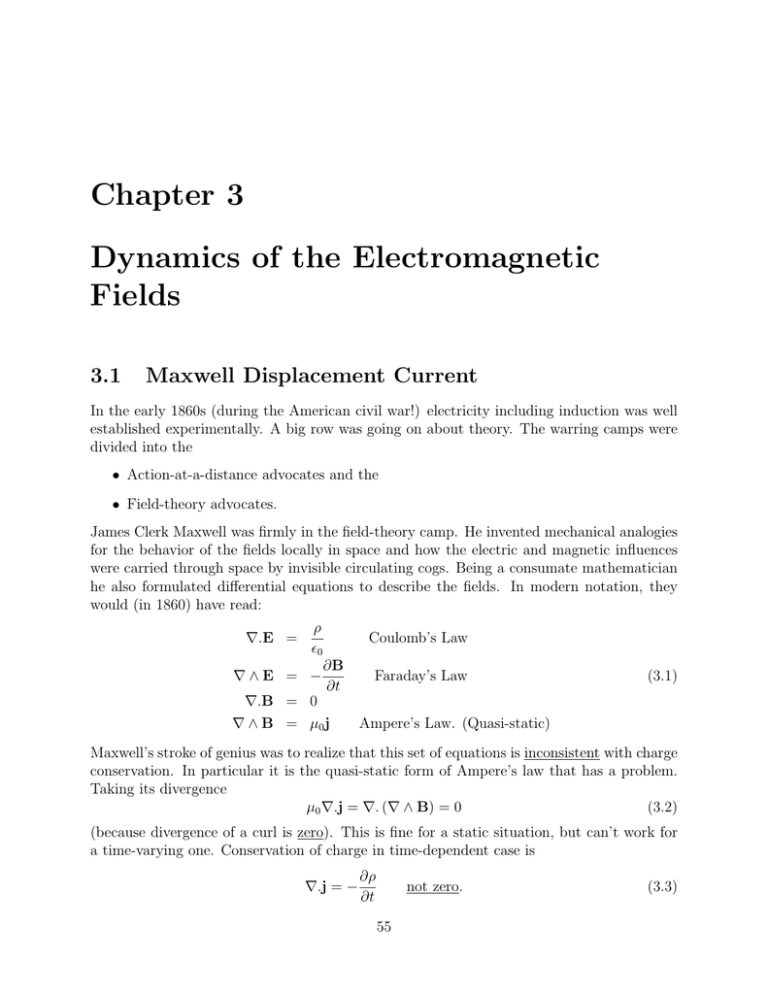
Chapter 3 Dynamics of the Electromagnetic Fields 3.1 Maxwell Displacement Current In the early 1860s (during the American civil war!) electricity including induction was well established experimentally. A big row was going on about theory. The warring camps were divided into the • Action-at-a-distance advocates and the • Field-theory advocates. James Clerk Maxwell was firmly in the field-theory camp. He invented mechanical analogies for the behavior of the fields locally in space and how the electric and magnetic influences were carried through space by invisible circulating cogs. Being a consumate mathematician he also formulated differential equations to describe the fields. In modern notation, they would (in 1860) have read: �.E = ρ �0 �∧E = − Coulomb’s Law ∂B ∂t �.B = 0 � ∧ B = µ0 j Faraday’s Law (3.1) Ampere’s Law. (Quasi-static) Maxwell’s stroke of genius was to realize that this set of equations is inconsistent with charge conservation. In particular it is the quasi-static form of Ampere’s law that has a problem. Taking its divergence µ0 �.j = �. (� ∧ B) = 0 (3.2) (because divergence of a curl is zero). This is fine for a static situation, but can’t work for a time-varying one. Conservation of charge in time-dependent case is �.j = − ∂ρ ∂t not zero. 55 (3.3) The problem can be fixed by adding an extra term to Ampere’s law because � ∂ρ ∂ ∂E �.j + = �.j + �0 �.E = �. j + �0 ∂t ∂t ∂t � (3.4) Therefore Ampere’s law is consistent with charge conservation only if it is really to be written with the quantity (j + �0 ∂E/∂t) replacing j. i.e. � ∂E j + �0 ∂t � ∧ B = µ0 � = µ 0 j + �0 µ0 ∂E ∂t (3.5) The term �0 ∂E/∂t is called Maxwell’s Displacement Current. There was, at the time, no experimental evidence for this term; still, the equations demanded it, as Maxwell saw. The addition makes the source-free forms (where ρ and j are zero) beautifully symmetric �∧E=− ∂B ∂t � ∧ B = µ0 � 0 ; ∂E ∂t . (3.6) Meaning a changing B-field induces an E-field (induction) but also a changing E-field induces a B-field. The extra term is also responsible, as we shall shortly see, for electromagnetic waves. Despite their elegance, the Maxwell equations did not settle the argument. The equa­ tions can be rewritten in integral form, similar to what the action-at-a-distance advocates wanted. However the action, it now became clear, could not be regarded as instantaneous. Moreover EM waves were not detected unequivocally for another 23 years! 3.2 3.2.1 Field Dynamics, Energy and Momentum Introduction Suppose we take a capacitor and charge it up using a power supply. During charging, a B I E V V I Stored Energy. Figure 3.1: Energy obtained from the power supply in “charging up” a capacitor or inductor is stored in the electromagnetic field. current I is flowing and at any instant potential is V = Q= � Idt , 56 I= Q C dQ dt . (3.7) Thus the power supply does work at rate IV (per sec) and total work done is � � dQ dt = V dQ dt � Q Q2 = dQ = Starting at Q = 0). C 2C IV dt = � V (3.8) (3.9) Where has this energy gone? Answer: into the electric field. The E-field within the capacitor stores energy with a volumetric energy density we shall calculate Now consider ‘charging’ an inductor with self-inductance L. V =L dI dt � . Work done V Idt = � LIdI = LI 2 2 (3.10) Where has this energy gone? The magnetic field. 3.2.2 Poynting’s Theorem: Energy Conservation How do we know, or show, that EM fields store and transport energy? Formally from a theorem derived from Maxwell’s Equations. Energy dissipation is the rate of doing work by fields on particles. Energy is transferred from fields to particles (and then often turned by some randomizing process into ‘heat’). Magnetic field does no work on particles because F ⊥ v. Electric field rate of doing work on a single particle is F.v = qE.v (3.11) Average rate of doing work on all particles in a volume V is � qj E (xj ) .vj (3.12) j in V so for an elemental volume dV such that E can be taken uniform across the volume, rate of work is � E. qj vj = E.�qnv�dV (3.13) j where n is the number/unit volume = density. The average �qnv� is just the current-density, j. Hence the energy dissipation (= work done on particles) rate (i.e. power) per unit volume is E.j (3.14) [Of course this is a localized form of the circuit equation P = V I]. We have the energy dissipation rate density E.j, but now we can express this in terms of the fields by using Ampere’s law: � � 1 ∂E E.j = E. � ∧ B − µ0 � 0 (3.15) µ0 ∂t Now we convert the form of the first term, E.(� ∧ B) using a vector identity �. (E ∧ B) = B. (� ∧ E) − E. (� ∧ B) 57 (3.16) so � 1 ∂E E.j = −�. (E ∧ B) + B. (� ∧ E) − µ0 �0 E. µ0 ∂t � (3.17) Then, using Faraday’s law � ∧ E = −∂B/∂t we have � 1 ∂B ∂E E.j = − �. (E ∧ B) + B. + µ0 �0 E. µ0 ∂t ∂t � (3.18) Note that if we had used the auxiliary fields D and H (which in vacuo are D = �0 E and H = B/µ0 ) we would have obtained � ∂B ∂D E.j = − �. (E ∧ H) + H. + E. ∂t ∂t � (3.19) which is entirely equivalent in the vacuum but subtly different for dielectric and magnetic media in the way energy accounting is done. Notice that this can be written (for vacuum) � ∂ E.j = − �. (E ∧ B/µ0 ) + 12 (B.B/µ0 + �0 E.E) ∂t � (3.20) Although it may not be obvious, this is now in the form of an energy conservation law. The physical meaning can be made obvious by considering an arbitrary volume V , with surface A. � V ∂ 1 [B.B/µ0 + �0 E.E] d3 x ∂t 2 V � � ∂ � 1� 2 = − (E ∧ B/µ0 ) .dA − B /µ0 + �0 E 2 d3 x ∂t V 2 A E.jd3 x = − � �. (E ∧ B/µ0 ) + (3.21) (3.22) This says that the total rate of work on particles in V is equal to minus the rate of change s = E ^B/ µ0 V dA Figure 3.2: Integral of Poynting flux over surface of V . of the integral over V of � 1� 2 B /µ0 + �0 E 2 (3.23) 2 minus the flux of the vector E ∧ B/µ0 across the surface A. Physically this says that 1 [B 2 /µ0 + �0 E 2 ] must be considered to be the electromagnetic energy density in the volume 2 58 V and the quantity E ∧ B/µ0 must be considered to be the energy flux density (across any surface). s = E ∧ B/µ0 = E ∧ H is called the “Poynting Vector”. If we write w ≡ 1 [B 2 /µ0 + �0 E 2 ] the energy density, then Poynting’s theorem is: 2 E.j = −�.s − ∂w . ∂t (3.24) The significance of the indentification of field energy density and energy flux density is immense. Even today we tend to think of electric power as being carried some how “in” the conducting cables. But if we understand Poynting’s theorem and EM theory we realize the power is carried by the fields as represented by E ∧ B/µ0 . Not by the electrons in the conductor, although they do carry the current. 3.2.3 Momentum Conservation The rate at which fields transfer momentum to particles is equal to the EM force q(E+v∧B) and the force density is f = ρE + j ∧ B . (3.25) Use Maxwell’s equations to eliminate ρ and j in favor of fields: � ρ = �0 �.E ; 1 ∂E j= � ∧ B − µ0 � 0 µ0 ∂t � . (3.26) Then � f = = = = � ∂E 1 �0 E (�.E) + B ∧ − B ∧ (� ∧ B) ∂t � 0 µ0 � � �� ∂ ∂B 1 1 �. (B.B) − (B.�) B − (�0 E ∧ B) + �0 − ∧ E + E (�.E) − � 0 µ0 2 ∂t ∂t � � ∂ 1 1 − (�0 E ∧ B) + �0 [(� ∧ E) ∧ E + E (�.E)] − �B 2 − (B.�) B ∂t µ0 2 � � ∂ 1 − (�0 E ∧ B) + �0 (E.�) E − � (E.E) + E (�.E) (3.27) ∂t 2 � � 1 1 + (B.�) B − � (B.B) + B (�.B) µ0 2 Now the last two terms can be written as the divergence �.T of a tensor quantity 1 1 1 T ≡ �0 EE − E 2 I + BB − B 2 I 2 µ0 2 � � � � (3.28) where I denotes the unit tensor. In suffix notation 1 1 1 Tij = �0 Ei Ej − E 2 δij + Bi Bj − Bδij µ0 2 2 � � 59 � � . (3.29) T is called the “Maxwell Stress Tensor.” And the force equation (Momentum conservation) becomes ∂ f = − (�0 E ∧ B) + �.T (3.30) ∂t which is, like Poynting’s theorem, in conservation form. Just as before, the physical meaning is seen by integration over a volume, finding that �0 E ∧ B = 1 1 E ∧ B/µ0 = 2 s 2 c c (3.31) is the volumetric field momentum density, and T is the force per unit area at a surface, i.e. the stress. Electromagnetic fields thus carry momentum density that is c12 times their energy flux density, where we have used the fact that �0 µ0 = c12 . By concentrating on E and B, leaving all charges and currents explicit in ρ and j we ex­ clude all “mechanical” energy and momentum associated e.g., with motion of or polarization of atoms or molecules or their constituent parts. (Even though that energy or momentum might be electromagnetic if we were dealing with E and B averaged across all atoms). Most confusion with energy and momentum in EM problems arises from not being clear about what counts in the EM energy/momentum versus particle energy/momentum. 3.3 Inductance, Energy, and Magnet Stresses Poynting’s theorem formalizes the observation we already made that the energy required to ‘charge up’ an inductance (i.e. raise the current in it) is stored in the magnetic field. We now know that the energy density is B 2 /2µ0 (in vacuuo) or 12 B.H in a linear magnetic medium (but most magnetic materials are not linear). Similarly the energy density stored in the electric field of a capacitor is �0 E 2 /2, or 12�ED. We also� found that the force density associated with B was governed by a tensor µ10 BB − 12 B 2 I the second term of which is of the same form as the energy density B 2 /2µ0 . There is a fundamental reason for this relationship that we can show by thinking about forces on magnets. 3.3.1 Relation between energy density and magnetic pressure in a solenoid Consider a solenoid formed by a current flowing azimuthally. It is easy to show that the EM force j ∧ B is always outward. Actually we can’t just take the total current and multiply by internal field to get the force, because j and B vary through the magnet. B = 0 outside. Instead of doing the integral of jB, let’s calculate the force by the method of “virtual work”. This involves imagining a small incremental motion, calculating energy changes and putting them equal to the work done F.dx. So ignore the thickness of conductor, and consider an expansion of the initial radius a by a small increment da. The stored magnetic energy (per � a B2 unit axial length) o 2µ0 2πrdr changes because a changes, and because B (possibly) changes. Actually, whether or not B changes depends on the external circuit attached to the solenoid through which the current flows. Let us choose to suppose that that circuit acts to keep the 60 j B j ^B a Figure 3.3: Force on a solenoid magnet. current constant so that B is constant. We need to calculate how much energy the circuit provides to the inductance. This requires the voltage during the expansion. Remembering Faraday’s law, � ∂Φ V = E.dl = − (3.32) ∂t If B is constant, Φ = πa2 B so dΦ da = B2πa (3.33) dt dt Hence the voltage induced in a single turn is V = −B2πa da dt . (3.34) The current per unit length needed to give B is µ0 J = B. So the work done by the external circuit is (per unit length) � −V Jdt = dWcircuit � B da B2πa dt µ0 dt (3.35) B2 = 2πada µ0 (3.36) (for a small incremental da). The change in stored magnetic energy is B2 3 B2 d x= 2πada = dWmagnetic 2µ0 2µ0 . (3.37) dWcircuit = dWmagnetic + dWmechanical (3.38) Then energy conservation is that where dWmechanical = 2πada.P and P is the force per unit length axially, per unit length azimuthally, i.e. the force per unit area or pressure. Substituting B2 B2 2πada = 2πada + P 2πada µ0 2µ0 61 (3.39) Hence P = B2 2µ0 (3.40) is the outward pressure exerted by the B-field on the magnet. Notice that we never invoked any force law such as the Maxwell stress tensor, we only used our knowledge of magnetic energy density. Also, the final result does not depend on our assumption about the external circuit. We could have assumed anything we liked. If we did the energy counting correctly, we would get the same force result. Also, if we assume the B-field distribution in the conductor does not change, then we don’t need to know what it is to obtain this result. So the total force/area on the magnet doesn’t depend on the current/field distribution in the magnet, provided the magnet is thin so that any energy stored in the magnetic field in the thickness of the magnet is small. Magnetic pressure is large for high fields. P = B2 = 4.0 × 105 B 2 Pa 2µ0 = 4B 2 bar. (3.41) 1T magnetic field pressure is 4 bar (∼ atmospheres). 10T B-field pressure is 40MPa (c.f. yield strength of hard copper ∼ 300M P a). For a thin cylinder, the stress (hoop stress) induced by a pressure P is a P (3.42) t a = radius, t = thickness. High field magnets have to be ‘chunky’ and even then soon run t σt θ Pθ σt a Figure 3.4: The hoop stress, σ in a thin cylinder balances the outward pressure, P . into stress limits. 3.4 Potentials for Time Varying Fields Electrostatic and Magnetostatic problems are most easily solved using the potentials φ and A. These potentials are also critical in time varying situations and general equations can be found as follows for the complete Maxwell equations. �.B = 0 means that 62 B=�∧A (3.43) is still a valid representation. Then �∧E=− ∂B ∂ ∂A = − � ∧ A = −� ∧ ∂t ∂t ∂t So � ∂A �∧ E+ ∂t (3.44) � =0 . (3.45) Therefore E + Ȧ (3.46) can be written as the gradient E + Ȧ = −�φ E = −�φ − or ∂A ∂t . (3.47) Then Coulomb’s law becomes � ρ ∂A = �.E = −�. �φ + �0 ∂t � = −�2 φ − ∂ (�.A) ∂t (3.48) and Ampere’s Law ∂E 1 1 µ0 j = � ∧ B − = � ∧ (� ∧ A) + 2 2 c ∂t c � � 2 1 ∂φ 1∂ A − �2 A + 2 2 = � �.A + 2 c ∂t c ∂t � ∂�φ ∂ 2 A + 2 ∂t ∂t � (3.49) Now remember that there is an arbitrariness to our choice of A since only its curl is equal to B. In point of fact we can choose �.A to be whatever we want. One choice, Coulomb gauge, was �.A = 0. “Lorentz Gauge”: �.A = − 1 ∂φ c2 ∂t . (3.50) Then 1 ∂ 2φ ρ =− 2 2 c ∂t �0 2 1∂ A �2 A − 2 2 = −µ0 j c ∂t �2 φ − (3.51) (3.52) Maxwell’s equations are completely equivalent to these wave equations with sources. (Plus Lorentz gauge condition.) Considered in this gauge, we see that the EM influence of ρ or j does not act instantaneously at-a-distance. Instead the influence has to propagate from the sources at the speed of light, c. 63 3.4.1 General Solutions We want to find the general solution to these equations. We work just on the φ equation be­ cause it is scalar. Its solution will generalize immediately. First let’s discuss the homogeneous equation 1 ∂ 2φ �2 φ − 2 2 = 0 (3.53) c ∂t which is satisfied wherever ρ = 0 (in vacuo). Also remember we can add any solution of this equation to a solution of the inhomogeneous eq. One solution type is plane waves, i.e. things ∂ ∂ that vary in only one direction. If we choose axes such that ∂y = ∂z = 0 then equation is 1-d: ∂2φ 1 ∂2φ − =0 (3.54) ∂x2 c2 ∂t2 The general solutions of this equation are φ (x, t) = f (x ± ct) . (3.55) That is, arbitrary shaped functions that move toward either increasing or decreasing x, preserving their shape. For our problem the more interesting case is spherically symmetric t= 0 t or x ct Figure 3.5: Arbitrary solution of the one-dimensional wave equation. waves. That is, in spherical coordinates (r, θ, χ) solutions such that �2 φ = ∂ ∂θ ∂ ∂χ = 1 ∂ 2 ∂φ 1 ∂ 2φ r = r2 ∂r ∂r2 c2 ∂t2 Make the substitution φ= = 0. Then (3.56) u r (3.57) then � � � � �� 1 ∂ 2 ∂φ 1 ∂ ∂u 1 u 1 ∂ ∂u r = 2 r2 − 2 = 2 r −u 2 r ∂r ∂r r ∂r ∂r r r r ∂r ∂r � � 1 ∂u ∂ 2 u ∂u 1 ∂2u = 2 +r 2 − = r ∂r ∂r ∂r r ∂r2 so 1 ∂ 2u ∂2u + =0 ∂r2 c2 ∂t2 64 (3.58) (3.59) So u satisfies the 1-d (planar) wave equation, with general solution f (r ± ct). Hence f (r ± ct) r φ= (3.60) is the general solution of the homogeneous wave equation that is spherically symmetric. Expanding (- sign) or converging (+ sign) radial waves. Actually this spherically symmetric solution doesn’t satisfy the homogeneous equation at r = 0 because of the singularity there. And in fact we already know from the static problem that �2 1 = −4πδ (r) = −4πδ (x − x� ) r (3.61) (taking the center of coordinate space to be x� ). Therefore, if f is everywhere non-singular, then � � 1 ∂ 2 f (r ± ct) 2 � − 2 2 = −4πf (±ct)δ (x − x� ) (3.62) c ∂t r So our solution φ = f (r±ct) is really the solution of the (mathematical) problem of calculating r the potential of a time-varying point charge at position x� , that is, of a charge density ρ = q(t)δ(x − x� ), where the charge is related to f by f (±ct) = q (t) 4π�0 f (r ± ct) = and hence q (t ± r/c) 4π�0 . (3.63) In short, the potential at position x due to a time-varying charge of magnitude q(t) at x� is φ(x, t) = q(t ± |x − x� |/c) 4π�0 |x − x� | (3.64) By considering the case where the charge is a delta-function in time, as well as space, q(t) = δ(t − t� ), we see that the Green Function G(x, t|x� , t� ) (in time and space) for the operator 1 ∂2 L ≡ �2 − 2 2 , (3.65) c ∂t namely the function that solves LG(x, t|x� , t� ) = δ(x − x� ) × δ(t − t� ), is � G (x, t|x� , t� ) = −δ t ± |x−x� | c − t� � (3.66) 4π |x − x� | and that the general solution of the electrostatic potential equation, �2 φ − is therefore φ (x, t) = 1 4π�0 1 ∂ 2φ ρ = − c2 ∂t2 �0 � � ρ x� , t ± |x − 65 |x−x� | c � x| (3.67) � d3 x� . (3.68) 3.5 Advanced and Retarded Solutions Notice we still have this ± sign in our potential solution. If we take the − sign, then the integrand is � � �| ρ x� , t − |x−x c . (3.69) |x − x� | This says that the contribution to our potential at x, t from a charge density at x� depends only on the value of that charge at the time t� = t − |x − x� | c (3.70) � This is earlier by the time it takes the EM influence to propagate from x� to x, i.e. by |x−cx | . A potential based on this sign is called the “retarded” potential because the influence arrives later than the charge: retarded. The time t� is called “retarded time” very often, despite being earlier. [In English retarded ≡ delayed.] If we were to take the + sign we would have the very peculiar result that the influence (i.e. potential) would depend on the charge density at a later time. The “advanced” solution from � ρ x� , t + |x − |x−x� | c x� | � (3.71) thus violates our ideas of causality. We generally hold that an effect (potential) can only arise from a cause (charge) if the cause is earlier in time. For that reason, the advanced potential is discarded as “unphysical” but the justification for this choice is mysterious, bound up in philosophical discussions of the arrow of time. Having obtained the general solution for the scalar wave equation with sources, we can immediately apply it to each vector component of the equation for A; so in summary: 1 � ρ (x� , t� ) 3 dx φ (x, t) = 4π�0 |x − x� | µ0 � j (x� , t� ) 3 � dx A (x, t) = 4π |x − x� | (3.72) (3.73) with t� = t − |x − x� |/c. Often the notation [[f]] is used to denote evaluation of any function f at retarded time. You must be extremely careful with taking differentials of retarded quantities because there is dependence on x not only in the space but also in the time argument. Thus, for example |x − x� | � f x ,t − c � � � � = �� [[f]] �= [[�� f]] the retarded value of a gradient is not equal to the gradient of the retarded value. 66 (3.74) In general |x − x� | f x� , t − c � � �� and |x − x� | ∂f = [[�� f]] + �� t − c ∂t �� �� � x−x ∂f = [[�� f]] + = �� [[f]] � c|x − x | ∂t �� �� x − x� ∂v � � � ∧ [[v]] = [[� ∧ v]] + ∧ . c|x − x� | ∂t �� � 67 � �� �� (3.75) (3.76) (3.77)


